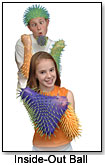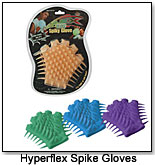
April 2, 2025


| Kids like to walk around the mall with Inside-Out Balls on their heads, inadvertently drumming up more business… |

“I’m having the time of my life,” says Chernick, describing the phenomenal response to Hyper-Flex. The line’s most popular item is the Inside-Out Ball: a super-soft fist-size ball that turns into a cluster of wiggly spikes when inverted. Kids are stretching them onto their heads like punk rockers in skullcaps, pulling them onto their feet like slippers and wearing them like gloves that reach to the elbow.
The line’s most popular item is the Inside-Out Ball: a super-soft fist-size ball that turns into a cluster of wiggly spikes when inverted. Kids are stretching them onto their heads like punk rockers in skullcaps, pulling them onto their feet like slippers and wearing them like gloves that reach to the elbow.
“They are one of our best sellers,” says Fabiano Fonseca, assistant retail manager for the Rainforest Café, a national restaurant and retail chain, in Costa Mesa, Calif.’s giant South Coast Plaza mall. Kids like to walk around the mall with Inside-Out Balls on their heads, inadvertently drumming up more business for the store and for Play Visions, Fonseca adds. “I had one lady call and ask for 40 of them.”
Play Visions, a design and manufacturing company outside of Seattle, owns the patent on Hyper-Flex. Therefore, they control the material’s use and its worldwide rights. “That’s a very unusual set of circumstances and a once-in-a-lifetime opportunity in the toy business,” says Chernick.
Chernick discovered Hyper-Flex almost by accident at a trade show in China. He asked to see “an orange-colored something” sticking up randomly at a factory owner’s booth and was told it wasn’t even finished yet, its function undetermined.
“But I recognized instantly that it was an unusual material and I thought there would be a tremendous use for it,” says Chernick. He asked for its worldwide rights on the spot. “I had a gut instinct about it.”
Play Vision’s development and marketing campaign followed a similarly instinctive approach, sans product testing. “We just packaged it really colorfully and threw it out on the market,” he notes.
The method worked. The product was voted the number-one impulse toy by MSNBC at this year’s American International Toy Fair, Chernick says, and nationally recognized chains, including Kmart, Toys "R" Us and Target, are calling it their best-selling novelty impulse buy.
Naturally, life hasn’t always been so sweet for Chernick, who started out producing stickers in 1981, and then moved into importing and distribution before founding Play Visions in 1990. In the past 15 years there have been plenty of clunkers, but lots of valuable lessons, too. What’s most important, Chernick has learned, is to listen to what customers and reps are saying about your merchandise.
“You can rely on your own instincts,” he says, “but not on your own opinions.”
Copyright © 2025 TDmonthly®, a division of TOYDIRECTORY.com®,
Inc.